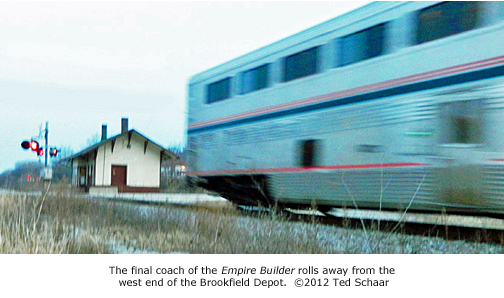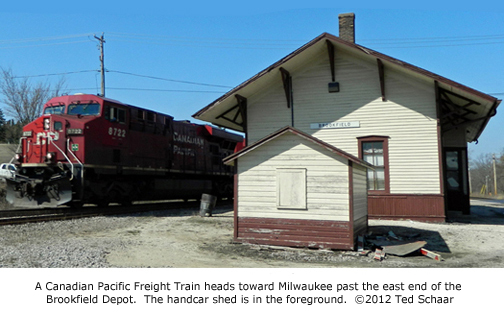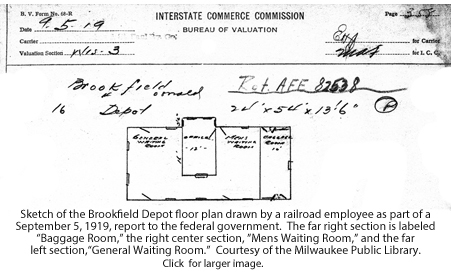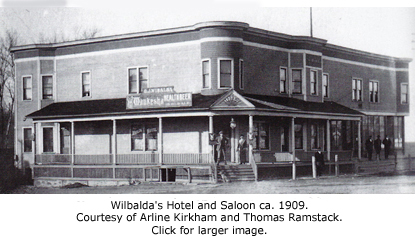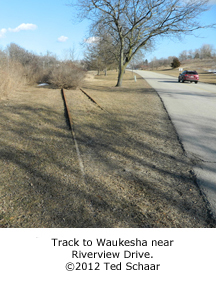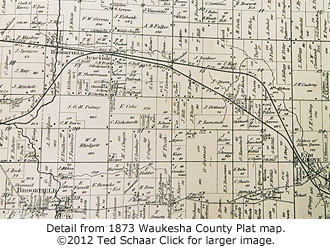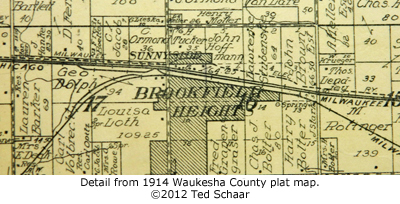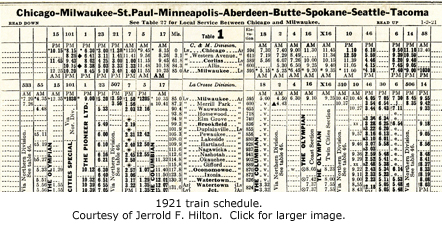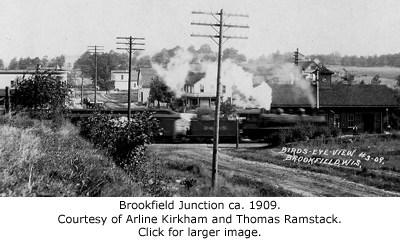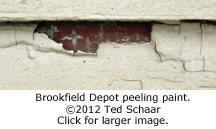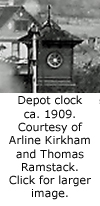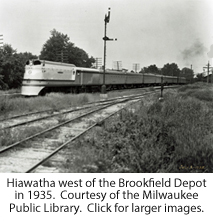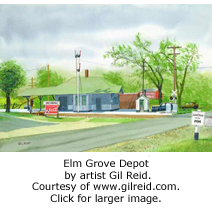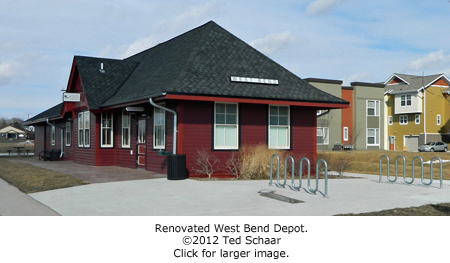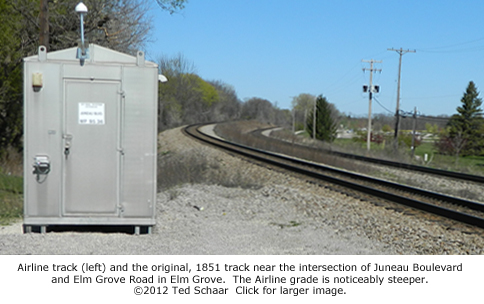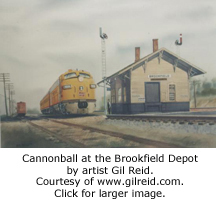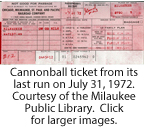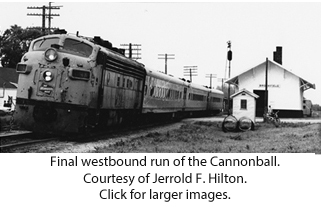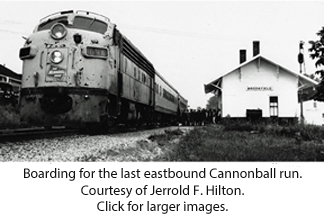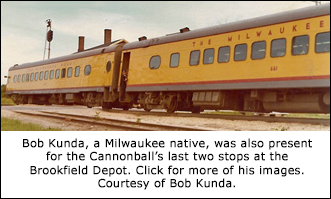©2012 Ted Schaar
Brookfield
and Elm Grove residents are familiar with two sets of rails that
run between the northwestern and southeastern corners of both
communities. Freight trains use the tracks most often but
twice a day, the Amtrak Empire
Builder rolls through.
Just east of Brookfield Road and several blocks north of North Avenue, the rails pass on either side of an abandoned train depot painted pale yellow with brown trim. Signs on the ends read "Brookfield."
I was surprised to learn that the depot was built in 1867 and is among the older surviving rail stations in the nation. Moreover, it replaced an earlier 1853 structure that one source reports was turned into a residence1 and another says burned down.2
Just east of Brookfield Road and several blocks north of North Avenue, the rails pass on either side of an abandoned train depot painted pale yellow with brown trim. Signs on the ends read "Brookfield."
I was surprised to learn that the depot was built in 1867 and is among the older surviving rail stations in the nation. Moreover, it replaced an earlier 1853 structure that one source reports was turned into a residence1 and another says burned down.2
Handcar shed
Off the east end is a matching
shed that once sheltered a handcar.3 Although
some think its presence dates to the 1920s, aerial photographs
commissioned by Waukesha County and taken every ten years
beginning in 1941 don't show it at its current location until
1970.4 Both buildings are owned by Canadian
Pacific railway.
During my 21 years in Brookfield, I've thought of the compact business district around the depot as the "village," and by the Victorian appearance of some nearby homes, knew it was the city's oldest neighborhood.
A few times, I had a beer or two in the long-gone Side Tracks Tavern that was on the ground floor of the building across Brookfield Road from the depot in a space now occupied by a gift shop.
On one occasion, a well-dressed, septuagenarian lady sat at the end of the bar and seemed completely out of place but, in fact, could not have been more at home. She was friendly and said her father had purchased the building decades earlier, and she had lived in it her entire life. At the time, she occupied an apartment on the upper floor.
Dale Plank, who runs the Plank Garage across the street, told me the woman I met was his Aunt Violet, now deceased. The building was erected in 19065 and originally called Wilbalda's Hotel and Saloon,6 which advertised "Waukesha Health Beer and Old Ale." Fay Plank, Dale Plank's grandfather, acquired the property in the second decade of the 20th century and renamed it the Plank Hotel. He also established the Plank Garage in 1938, and initially it was operated by his son, James, Dale's father.
I never thought much about the trains—other than hearing their whistles and horns and waiting for them at crossings—until I took a trip on the Empire Builder to help my son move from Minneapolis to New Berlin. A station in Tomah that was built in the early 1900s reminded me of the Brookfield Depot and made me curious about its age. When I found out, I wondered why two sets of tracks run through Brookfield and Elm Grove in the first place. I discovered, not surprisingly, the answer is location, location, location; that is, geography.
During my 21 years in Brookfield, I've thought of the compact business district around the depot as the "village," and by the Victorian appearance of some nearby homes, knew it was the city's oldest neighborhood.
A few times, I had a beer or two in the long-gone Side Tracks Tavern that was on the ground floor of the building across Brookfield Road from the depot in a space now occupied by a gift shop.
On one occasion, a well-dressed, septuagenarian lady sat at the end of the bar and seemed completely out of place but, in fact, could not have been more at home. She was friendly and said her father had purchased the building decades earlier, and she had lived in it her entire life. At the time, she occupied an apartment on the upper floor.
Dale Plank, who runs the Plank Garage across the street, told me the woman I met was his Aunt Violet, now deceased. The building was erected in 19065 and originally called Wilbalda's Hotel and Saloon,6 which advertised "Waukesha Health Beer and Old Ale." Fay Plank, Dale Plank's grandfather, acquired the property in the second decade of the 20th century and renamed it the Plank Hotel. He also established the Plank Garage in 1938, and initially it was operated by his son, James, Dale's father.
I never thought much about the trains—other than hearing their whistles and horns and waiting for them at crossings—until I took a trip on the Empire Builder to help my son move from Minneapolis to New Berlin. A station in Tomah that was built in the early 1900s reminded me of the Brookfield Depot and made me curious about its age. When I found out, I wondered why two sets of tracks run through Brookfield and Elm Grove in the first place. I discovered, not surprisingly, the answer is location, location, location; that is, geography.
Niagara
Escarpment
When investors formed the
Milwaukee and Mississippi Rail Road Company in the middle 1800s,
they wanted to lay track from Milwaukee to Waukesha and ultimately
the Mississippi River but faced a major obstacle: the steep ridge
that stands between the two cities and is straddled by
Brookfield.
Residents know it as the subcontinental divide, but it's actually part of a huge geologic feature called the Niagara Escarpment that stretches in a sweeping arc from Northern Illinois up the eastern edge of Wisconsin; around Lakes Michigan, Huron, and Ontario; and all the way to upstate New York where it ends near Rochester.
Going directly to Waukesha meant climbing the escarpment, a difficult challenge for locomotives pulling heavy trains so the search was on for an alternate route. Surveyors soon discovered a meandering path along the valleys of three waterways: the Menomonee River, Underwood Creek, and Fox River (a tributary of the Illinois River not to be confused with the completely separate Fox River that flows into the Bay of Green Bay).
The track that was built follows the Menomonee River out of Milwaukee into Wauwatosa and continues northwest along Underwood Creek through Elm Grove. Today it crosses into Brookfield on a viaduct over North Avenue that is located about three-quarters of a mile east of the arterial's intersection with Pilgrim Parkway. It continues in a northerly direction for a short distance, then takes a curving left turn, heads nearly due west along the northern border of Wirth Park, and crosses Pilgrim and Calhoun.
After passing the depot and Brookfield Road, it originally curved south near the Brookfield Recycling Center, crossed what is now Riverview Drive, and followed the Fox River valley to downtown Waukesha.
The inaugural run on the line took place February 25, 1851, to great hoopla,7 and regular service for what was Wisconsin's first railroad began just over a week later on March 4. The track was 20.5 miles long and cost $268,820 to build,8 which is about $6.9 million in 2012 dollars.9
Lifelong rail enthusiast, writer, and retired executive Jerrold Hilton, who lives in Brookfield, said the portion along the Fox River was used until "sometime after the Soo Line acquired it in February 1985." The right-of-way was later obtained by the State of Wisconsin according to Frank Huntington, supervisor, Rail Project and Property Management Unit, Wisconsin Department of Transportation, who said, "the railroad was paid for the land, track, and other improvements." Waukesha County then purchased it from the state with "the deed officially recorded on January 3, 2001," said David Burch, manager of enterprise operations, who added that plans are in place to convert it to a trail for bicyclists, hikers, runners, and other recreational users although he wasn't sure when that might happen.
The second line started as a track between Brookfield and Watertown, a distance of 31 miles, and was completed in 185510 by the Milwaukee & Watertown Railroad, which became the Milwaukee & St. Paul Railroad, later known as The Milwaukee Road.
Residents know it as the subcontinental divide, but it's actually part of a huge geologic feature called the Niagara Escarpment that stretches in a sweeping arc from Northern Illinois up the eastern edge of Wisconsin; around Lakes Michigan, Huron, and Ontario; and all the way to upstate New York where it ends near Rochester.
Going directly to Waukesha meant climbing the escarpment, a difficult challenge for locomotives pulling heavy trains so the search was on for an alternate route. Surveyors soon discovered a meandering path along the valleys of three waterways: the Menomonee River, Underwood Creek, and Fox River (a tributary of the Illinois River not to be confused with the completely separate Fox River that flows into the Bay of Green Bay).
The track that was built follows the Menomonee River out of Milwaukee into Wauwatosa and continues northwest along Underwood Creek through Elm Grove. Today it crosses into Brookfield on a viaduct over North Avenue that is located about three-quarters of a mile east of the arterial's intersection with Pilgrim Parkway. It continues in a northerly direction for a short distance, then takes a curving left turn, heads nearly due west along the northern border of Wirth Park, and crosses Pilgrim and Calhoun.
After passing the depot and Brookfield Road, it originally curved south near the Brookfield Recycling Center, crossed what is now Riverview Drive, and followed the Fox River valley to downtown Waukesha.
The inaugural run on the line took place February 25, 1851, to great hoopla,7 and regular service for what was Wisconsin's first railroad began just over a week later on March 4. The track was 20.5 miles long and cost $268,820 to build,8 which is about $6.9 million in 2012 dollars.9
Lifelong rail enthusiast, writer, and retired executive Jerrold Hilton, who lives in Brookfield, said the portion along the Fox River was used until "sometime after the Soo Line acquired it in February 1985." The right-of-way was later obtained by the State of Wisconsin according to Frank Huntington, supervisor, Rail Project and Property Management Unit, Wisconsin Department of Transportation, who said, "the railroad was paid for the land, track, and other improvements." Waukesha County then purchased it from the state with "the deed officially recorded on January 3, 2001," said David Burch, manager of enterprise operations, who added that plans are in place to convert it to a trail for bicyclists, hikers, runners, and other recreational users although he wasn't sure when that might happen.
The second line started as a track between Brookfield and Watertown, a distance of 31 miles, and was completed in 185510 by the Milwaukee & Watertown Railroad, which became the Milwaukee & St. Paul Railroad, later known as The Milwaukee Road.
Name
from the past
At the time Brookfield was a
remote farming community named by early settlers who emigrated
from an area near the township of North Brookfield, New York11
and must have thought their new home's numerous streams and
marshes made a watery name from their past fit perfectly.
Where the two tracks met in its midst was called Brookfield
Junction. An 1873 Waukesha County plat map uses Brookfield
alone to name an area in the vicinity of the Blue Mound Road and
Brookfield Road intersection not far from Goerke's Corners.
Further
confusing the picture, a 1900 Waukesha
Freeman article about an industrial accident labels the
junction area "Brookfield Heights"12 as does a Waukesha
County plat map from 1914.
Theron W. Haight in Memoirs of Waukesha Country, published in 1907, wrote that the junction area at that time contained "...about 400 inhabitants. Two physicians and one attorney are located in the village, and the three hotels have accommodations for 100 guests."13 Although I haven't been able to determine it with certainty, research indicates the Railroad Hotel, located at 2910 North Brookfield Road14 and Eichsteadt Hotel, address unknown, accommodated travelers along with the Scholl Hotel,15 which was destroyed by a fire in 1905, rebuilt as Wilbalda's Hotel and Saloon,16 and later renamed the Plank Hotel.
There might have been one more. John Becker of Becker's Pit Stop, 2915 North Brookfield Road, told me a combination hotel-saloon named Huberty's once did business to the north of his location.
Theron W. Haight in Memoirs of Waukesha Country, published in 1907, wrote that the junction area at that time contained "...about 400 inhabitants. Two physicians and one attorney are located in the village, and the three hotels have accommodations for 100 guests."13 Although I haven't been able to determine it with certainty, research indicates the Railroad Hotel, located at 2910 North Brookfield Road14 and Eichsteadt Hotel, address unknown, accommodated travelers along with the Scholl Hotel,15 which was destroyed by a fire in 1905, rebuilt as Wilbalda's Hotel and Saloon,16 and later renamed the Plank Hotel.
There might have been one more. John Becker of Becker's Pit Stop, 2915 North Brookfield Road, told me a combination hotel-saloon named Huberty's once did business to the north of his location.
Many
arrivals and departures
Amtrak's Empire
Builder still rolls past the Brookfield depot at about
1:45 p.m. eastbound from the west coast to Chicago and at about
4:15 p.m. westbound to Spokane, Portland, and Seattle.
But it doesn't stop.
The depot was once a fairly busy place as evidenced by a 91-year-old timetable Hilton wrote about in an article for The Milwaukee Railroader magazine: "The January 2, 1921, timetable shows 11 trains per day stopping in each direction! These included three trains a day to Marquette, Iowa, two via Watertown and Madison, and one via Waukesha, Milton, and Madison."17
More information about activities at the depot was discovered by author Thomas Ramstack. In his book, Brookfield and Elm Grove, he cites a Milwaukee Journal article from 1902 that contains the following: "Nearly 100 eight-gallon cans of milk are shipped from Brookfield Junction to Milwaukee daily at about 90 cents per can."18
Retired Southeastern Wisconsin Regional Planning Commission principal planner in the transportation division Otto Dobnick, who focused on railroads, reflected: "From about the 1850s to the 1950s, a rail depot was the front door of the community; that's how virtually everything came to town, from lumber to mail to food, even to soldiers returning from war. And that's how most things left. For about a century, people were very much attuned to what was happening at the rail depot."
The depot was once a fairly busy place as evidenced by a 91-year-old timetable Hilton wrote about in an article for The Milwaukee Railroader magazine: "The January 2, 1921, timetable shows 11 trains per day stopping in each direction! These included three trains a day to Marquette, Iowa, two via Watertown and Madison, and one via Waukesha, Milton, and Madison."17
More information about activities at the depot was discovered by author Thomas Ramstack. In his book, Brookfield and Elm Grove, he cites a Milwaukee Journal article from 1902 that contains the following: "Nearly 100 eight-gallon cans of milk are shipped from Brookfield Junction to Milwaukee daily at about 90 cents per can."18
Retired Southeastern Wisconsin Regional Planning Commission principal planner in the transportation division Otto Dobnick, who focused on railroads, reflected: "From about the 1850s to the 1950s, a rail depot was the front door of the community; that's how virtually everything came to town, from lumber to mail to food, even to soldiers returning from war. And that's how most things left. For about a century, people were very much attuned to what was happening at the rail depot."
Clock
tower
Brian Faltinson, of Heritage
Research, Ltd., in a document he calls an "historic building
evaluation" whose purpose was to determine whether the Brookfield
depot meets criteria for listing on the National Register of
Historical Places (it does, he concluded) wrote that a circa
1907 photograph shows the depot: "...surrounded by a brick-paved
passenger loading area. At that
time, the building possessed a wooden cupola with a clock on its
roof. This element was removed sometime after 1939."19
Early photographs also show the depot was a darker color. Marion Bruhn, curator of the Elmbrook Historical Society, thinks it might have been red, the color of many early cabooses. "Red is attention-getting," she said.
Jim Scribbins, a retired Milwaukee Road management employee who authored several books about railroads, including one focused on the famed Hiawatha train, remembers it was light gray in the 1940s and '50s. He thought the trim was a contrasting color but couldn't recall what it was. Jerry Becker, John's father, who has visited and worked in Brookfield Junction since the 1940s, said it seemed to him the depot was painted light green in the 1950s. While walking around the Brookfield depot with Hilton, I noticed a section of peeling paint and took the accompanying photograph; it reveals what appears to be a crimson color.
Early photographs also show the depot was a darker color. Marion Bruhn, curator of the Elmbrook Historical Society, thinks it might have been red, the color of many early cabooses. "Red is attention-getting," she said.
Jim Scribbins, a retired Milwaukee Road management employee who authored several books about railroads, including one focused on the famed Hiawatha train, remembers it was light gray in the 1940s and '50s. He thought the trim was a contrasting color but couldn't recall what it was. Jerry Becker, John's father, who has visited and worked in Brookfield Junction since the 1940s, said it seemed to him the depot was painted light green in the 1950s. While walking around the Brookfield depot with Hilton, I noticed a section of peeling paint and took the accompanying photograph; it reveals what appears to be a crimson color.
West
Bend depot renovation
A train depot in West Bend that
was built in 190020
and renovated in a project completed in 2010 now has what are
thought to be its original colors. Shawn Graff,
executive director of The Ozaukee Washington Land Trust, Inc.,
which is housed in the depot, said a paint analysis of the
building was done to discover and replicate a color he described
as "boxcar red." However,
an
employee of Isthmus Architecture, the Madison firm that managed
the refurbishment, said that wasn't true; instead, the current
finish is based on the corporate colors of the depot's builder,
Chicago and North Western railway. In any case, people like
the result according to Julie A. Cayo, community development
planner for the City of West Bend: "The depot restoration
was a popular project with residents, and we're very happy with
it," she said.
Airline
The second track through
Brookfield and Elm Grove was completed in 1864.21
It parallels the 1851 rail from Brookfield Junction east but veers
off to skirt Wirth Park's southern border, crosses into Elm Grove
where North Avenue intersects with Pilgrim Parkway, and rejoins
the first track in the middle of Elm Grove. The two run
together past Reinders on Watertown Plank, which is just across
the street from where the Elm Grove Train Depot once stood on a
lot now occupied by One Hour Martinizing. The depot was
destroyed by a derailed freight train in the early morning hours
of Saturday, April 19, 1958,22 and never rebuilt.
Just south of the Elm Grove Recycling Center, the tracks diverged again. The original curved to the east, but the second track headed nearly due south, crossed Blue Mound Road, and didn't turn east until it was south of the current location of I-94. From there it was laid in a nearly straight easterly line to the Milwaukee train station. It was known as the "Airline," an industry term used to describe a rail that connects two points using the shortest practical route. Its grade was steeper than the sinuous first line, but the amount of land cleared and track laid was significantly smaller. Railroads used it mainly for eastbound trains and depended on the original line for westbound traffic.
Just south of the Elm Grove Recycling Center, the tracks diverged again. The original curved to the east, but the second track headed nearly due south, crossed Blue Mound Road, and didn't turn east until it was south of the current location of I-94. From there it was laid in a nearly straight easterly line to the Milwaukee train station. It was known as the "Airline," an industry term used to describe a rail that connects two points using the shortest practical route. Its grade was steeper than the sinuous first line, but the amount of land cleared and track laid was significantly smaller. Railroads used it mainly for eastbound trains and depended on the original line for westbound traffic.
Path
of the original track?
Determining which of the two
Brookfield and Elm Grove tracks was the original 1851 rail wasn't
easy. WisDOT personnel were unsure, and rail
aficionados I consulted had varying opinions.
Don Ditmarr, manager, land information systems, Waukesha County, suggested I talk with his colleague Jason Fruth, planning and zoning manager, who recommended I talk with his predecessor, Richard Mace, now retired. Reached in northern Wisconsin, Mace referred me to Senior Land Use Specialist Mary Finet who remembered old plat map books were stored in the Waukesha County register of deeds office. She looked at 1873, 1914, and 1930 editions for the Brookfield-Elm Grove area and determined the original track was the one that curves north of Wirth Park. I visited the office, was given access to the books by Deputy Register of Deeds Christine Crouch, took photographs, and have used details from the images to illustrate this story. The 1930 map shows the path of the tracks and makes it clear the Airline, which crossed what was then called "US 16-18"—modern Blue Mound Road—was the one that ran south of Wirth Park.
Later a third track was laid next to the original from Elm Grove to Milwaukee and is still in use today. "It was installed in the early 1900s," Scribbins said, "with the goal of making a 'double-track' railroad into and out of Milwaukee."
Don Ditmarr, manager, land information systems, Waukesha County, suggested I talk with his colleague Jason Fruth, planning and zoning manager, who recommended I talk with his predecessor, Richard Mace, now retired. Reached in northern Wisconsin, Mace referred me to Senior Land Use Specialist Mary Finet who remembered old plat map books were stored in the Waukesha County register of deeds office. She looked at 1873, 1914, and 1930 editions for the Brookfield-Elm Grove area and determined the original track was the one that curves north of Wirth Park. I visited the office, was given access to the books by Deputy Register of Deeds Christine Crouch, took photographs, and have used details from the images to illustrate this story. The 1930 map shows the path of the tracks and makes it clear the Airline, which crossed what was then called "US 16-18"—modern Blue Mound Road—was the one that ran south of Wirth Park.
Later a third track was laid next to the original from Elm Grove to Milwaukee and is still in use today. "It was installed in the early 1900s," Scribbins said, "with the goal of making a 'double-track' railroad into and out of Milwaukee."
Well-used
rails
The tracks still carry a great
deal of traffic according to CP Media Relations Manager Kevin
Hrysak, who has an office in Calgary, a city in the province of
Alberta. Responding to e-mailed questions, he stated:
"Through our Chicago to Minneapolis corridor which encompasses
Brookfield, we run 32-34 trains in a 24-hour period. I would say
that an average train today is 5,000 to 6,000 feet in length and
can carry between 100-120 rail cars. The majority of our
locomotives are purchased from General Electric, and I believe
they come out of Erie, Pennsylvania. As for rail cars, they can
come from various manufacturers, and CP does not own all the rail
cars that travel on our lines; many customers and governments own
the cars that haul their product. This corridor carries a wide
range of freight, from consumers goods to forest products, grain,
coal, potash, energy products, automotive parts, and vehicles."
For many years, the Airline served manufacturing and distribution facilities in the Menomonee Valley, running through what was called the Airline Yard in the vicinity of 35th Street. But as Milwaukee's industrial base declined, the track was used less and ultimately the State of Wisconsin purchased it from CP, Huntington said: "That corridor is under the Federal Rails to Trails Program and owned by Wisconsin Department of Natural Resources."
The tracks and ties south of Blue Mound Road were removed in 2006, and the Hank Aaron Trail now occupies the former rail bed. "Converting the route to recreational use is a way to preserve the corridor in case it's ever needed for transportation purposes again," said Melissa Cook, DNR trail manager. "Meanwhile, it provides a lot of enjoyment to citizens."
For many years, the Airline served manufacturing and distribution facilities in the Menomonee Valley, running through what was called the Airline Yard in the vicinity of 35th Street. But as Milwaukee's industrial base declined, the track was used less and ultimately the State of Wisconsin purchased it from CP, Huntington said: "That corridor is under the Federal Rails to Trails Program and owned by Wisconsin Department of Natural Resources."
The tracks and ties south of Blue Mound Road were removed in 2006, and the Hank Aaron Trail now occupies the former rail bed. "Converting the route to recreational use is a way to preserve the corridor in case it's ever needed for transportation purposes again," said Melissa Cook, DNR trail manager. "Meanwhile, it provides a lot of enjoyment to citizens."
Cannonball
With the rise of cars and trucks
and improved roads, trains stopped at the Brookfield Depot less
often until only one was left, a commuter service that ran between
Watertown and Milwaukee, with stops in Wauwatosa, Brookfield,
Pewaukee, Hartland, Oconomowoc, and several other communities.23
The trains were operated by the Milwaukee Road which
designated the eastbound Number 12 and the westbound, Number 23.
"By the early 1940s," Scribbins said, "passengers were calling it
the 'Cannonball,' and the name stuck." Plank
recalled riding the Cannonball now and then and estimates the trip
from Brookfield to downtown Milwaukee took just 20 minutes.
The end of the line came on July 31, 1972. A Milwaukee Journal story about the last run said the commuter train "traveled 70 miles an hour" but averaged "no more than 50 to 60 passengers a day."24
Normally, the Cannonball consisted of a locomotive and two coaches, but on its final day, an extra car was added to accommodate those wanting one last ride according a website dedicated to fine-art painter and railroad aficionado Gil Reid who completed many canvases featuring trains, including one of the Cannonball parked at the Brookfield Depot.25 It is an idealized portrait that depicts a train quite different from the battered equipment revealed in photographs Hilton took of the Cannonball's last stops in Brookfield. Coincidentally, Mace, a longtime friend of Reid who also helped me identify which track was the first to run through Brookfield, owns the rights to many of the artist's works and was kind enough to provide the accompanying photos of Reid paintings to help illustrate this story.
The end of the line came on July 31, 1972. A Milwaukee Journal story about the last run said the commuter train "traveled 70 miles an hour" but averaged "no more than 50 to 60 passengers a day."24
Normally, the Cannonball consisted of a locomotive and two coaches, but on its final day, an extra car was added to accommodate those wanting one last ride according a website dedicated to fine-art painter and railroad aficionado Gil Reid who completed many canvases featuring trains, including one of the Cannonball parked at the Brookfield Depot.25 It is an idealized portrait that depicts a train quite different from the battered equipment revealed in photographs Hilton took of the Cannonball's last stops in Brookfield. Coincidentally, Mace, a longtime friend of Reid who also helped me identify which track was the first to run through Brookfield, owns the rights to many of the artist's works and was kind enough to provide the accompanying photos of Reid paintings to help illustrate this story.
Plans
on hold
Once a busy place in a rural
hamlet, the depot now sits empty except for random debris
deposited by rail crews. It almost returned to some
semblance of its former importance when high-speed passenger
service from Milwaukee to Madison was proposed and Wisconsin was
awarded an $810 million federal allocation to fund it. The
plan included a stop in Brookfield.26
Dan Ertl, director, Brookfield Department of Community Development, said the depot didn't meet modern Amtrak standards, so preliminary plans called for moving it across Brookfield Road and using it as the trailhead for a new bike and pedestrian path on the 1851 rail bed to Waukesha. "We were going to renovate the building," Ertl recalled, "give the interior a railroad theme, and provide lavatory facilities for people using the trail."
A new station would have been built about 800 feet to the east of the current depot, so stopped trains wouldn't block traffic on Brookfield Road while they dropped off or picked up passengers. All planning was put on hold when Governor Scott Walker rejected the federal funds in December, 2010, declaring in a press release: "The Madison to Milwaukee train line is dead."27
Trains, nevertheless, will continue rolling through our area, as they have for better than a century and a half, but they won't stop...as they haven't for more than four decades.
Dan Ertl, director, Brookfield Department of Community Development, said the depot didn't meet modern Amtrak standards, so preliminary plans called for moving it across Brookfield Road and using it as the trailhead for a new bike and pedestrian path on the 1851 rail bed to Waukesha. "We were going to renovate the building," Ertl recalled, "give the interior a railroad theme, and provide lavatory facilities for people using the trail."
A new station would have been built about 800 feet to the east of the current depot, so stopped trains wouldn't block traffic on Brookfield Road while they dropped off or picked up passengers. All planning was put on hold when Governor Scott Walker rejected the federal funds in December, 2010, declaring in a press release: "The Madison to Milwaukee train line is dead."27
Trains, nevertheless, will continue rolling through our area, as they have for better than a century and a half, but they won't stop...as they haven't for more than four decades.
* * *
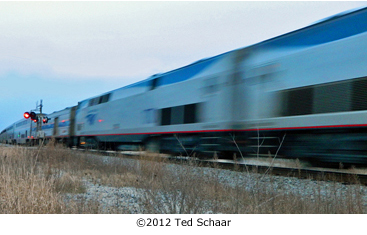
Footnotes
1. The History/Landmark Tour Of Brookfield And Elm Grove, Elmbrook Historical Society, page 30.
2. "Brookfield more than a whistle-stop," July 27, 2003, Milwaukee Journal Sentinel.
3. "State Historical Society of Wisconsin Determination of Eligibility Form," Brian Faltinson, 2000,
page 4.
4. http://www.waukeshacounty.gov/defaultwc.aspx?id=39458.
5. Following the Trail, Stephen K. Hauser and Jean R. Stackpole, Heritage House Publishing, 1998,
page 54.
6. Brookfield and Elm Grove, Thomas Ramstack, 2009, Arcadia Publishing, page 48.
7. Steam and Cinders, Axel Lorenzsonn, 2009, Wisconsin State Historical Society, page 109.
8. Ibid, page 112.
9. http://www.westegg.com/inflation/
10. "The Railroads of Wisconsin 1827--1937." Railway & Locomotive Historical Society, Chas. E.
Fisher, editor, 1937. Page 20.
11. Brookfield and Elm Grove, Thomas Ramstack, 2009, Arcadia Publishing, page 11.
12. Ibid, page 34.
13. Memoirs of Waukesha County, Theron W. Haight, 1907, Western Historical Association, page 269.
14. The History/Landmark Tour Of Brookfield And Elm Grove, Elmbrook Historical Society, 2007, Alphagraphics, page 30.
15. http://www.linkstothepast.com/waukesha/disaster-fires.php
16. Brookfield and Elm Grove, Thomas Ramstack, 2009, Arcadia Publishing, page 48.
17. The Milwaukee Railroader, "Brookfield and Elm Grove," Jerrod Hilton and the TMR Staff, First
Quarter, 2011, page 12.
18. Brookfield and Elm Grove, Thomas Ramstack, 2009, Arcadia Publishing, page 58.
19. "State Historical Society of Wisconsin Determination of Eligibility Form," Brian Faltinson, 2000,
page 6.
20. "Historic West Bend Depot," brochure, page 4.
21. The Railroads of Wisconsin 1827--1937, Railway & Locomotive Historical Society, Chas. E.
Fisher, editor, 1937. Page 20.
22. "Crews Work Into Night at Wreck Scene," Milwaukee Journal, April 20, 1958. Front page.
23. "Cannonball Jogs Memory," The Milwaukee Journal, May 28, 1979.
24. "Cannonball Chugs to Last Goodby," Milwaukee Journal, August 1, 1972.
25. http://www.gilreid.com/Galleries/intrurbn_diesels.htm
26. http://www.usatoday.com/travel/destinations/2010-05-10-wisconsin-high-speed-rail_N.htm
27. "Governor-elect Walker
statement on Madison-Milwaukee train line" (Thursday, December 09,
2010);http://www.wisgov.state.wi.us/Default.aspx?Page=971d8fbe-0000-4e9a-8c54-a3501f00855e
* * *
